Publications
Press Release, 22 Oct 2015
DDI Heat Exchangers Inc., and Energy Recovery Solution
are proud to announce:
DDI will be heading to Hong Kong to participate as an exhibitor and participant in the Environment and Green Building Trade Mission to Eco Expo Asia 2015.
DDI will also join the trade delegation of Mr. Denis Coderre, the Mayor of the City of Montreal mission to Shanghai China.
A brief (2 pages) file is on our web, with a quick summary of the Benefits and ways that the DDI very wide gap Heat Exchangers can Recover Energy in 3 different applications. In 1-Building’s Grey Water, 2- City Sewage, 3- WWTP.
http://ddi-heatexchangers.com/technical-summary/
Some of the References for the Sewage project are at bottom of the page.
http://ddi-heatexchangers.com/city-sewage-energy/
Regards Erwin Schwartz / B. Eng. / Management. President DDI-Heat Exchangers Inc Tel: 514-696-7961
Fax: 514-696-8344 Email: erwin@ddi-heatexchangers.com
WebPages:
www.energyrecoverysolution.com
Heat recovery exchangers
Heat recovery exchangers from DDI Heat Exchangers provide non-plug operation despite stringy and sticky materials in municipal sludge. The systems reduce carbon dioxide emissions and provide unobstructed liquid flow. The compact units require a small footprint and provide reliable and maintenance-free operation. 514/696-7961; www.ddi-heatexchangers.com.
Reusing waste
Rectangular Square Cube heat exchangers from DDI-Heat Exchangers Inc. have compact, rectangular flow channels that minimize plugging. Sludge-to-sludge heat recovery exchangers, hot water-to-preheated sludge, and cold water-to-processed sludge heat exchangers are available. Systems using sludge-to-sludge heat recovery could see a payback in four to seven months.
The units have a large heat transfer surface, small footprint, more turbulence, 3-inch gaps to limit sludge blockage, full access to internals via doors, davit arms on swinging doors, optimum height for fast flow, realistic viscosity calculations, thick layers against abrasion (0.25- to 0.375-inch minimum), and a backup that uses the sludge-to-sludge heat exchangers for the water-to-sludge process. All are low maintenance. 514/696-7961; www.ddi-heatexchangers.com.
Heat-recovery exchanger
DDI heat-recovery exchangers use water and direct sludge-to-sludge heat recovery. The units are designed to be compact and efficient and limit plugging and baking. 514/696-7961; www.ddi-heatexchangers.com.
Heat exchange system
The HX heat exchanger system from DDI Heat Exchangers can connect to sewage lines and integrate into a building’s heating and ventilation system to recover heat and cooling energy from sewage. It is easy to access, low in maintenance and reliable. It can be easily integrated with existing wastewater infrastructures. 514/696-7961; www.ddi-heatexchangers.com.
Heat exchangers stop clogging and baking
Problem
Holes in three tube-in-tube heat exchangers at the Stanely Street Wastewater Treatment Plant in Niagara City, Ont., affected the heating of sludge with hot water. Heat exchanger replacements would have to fit through a 5-foot-square hatch in the roof, then be rolled down a long, winding corridor.
Solution
The facility bought rectangular-channeled heat exchangers from DDI Heat Exchangers to handle viscous material. The nonblock design has 3-inch gaps to prevent sludge blockage and no spacers for both liquids. The 3-feet-per-second flow prevents baking, while creating more turbulence for better heat transfer.
Although the units have a small footprint, their larger circumference reduces the need for macerators. A full door makes it easy to clean them every few years. DDI added a hoist bar to the exchangers for lowering them down the hatch with a crane, and rollers for maneuvering them into position.
Result
The heat exchangers are operating as specified. 514/696-7961; www.ddi-heatexchangers.com.
DDI Offers Rectangular Square Cube Heat Exchanger
The Rectangular Square Cube sludge-to-sludge heat recovery exchanger from DDI Heat Exchangers Inc. features compact rectangular flow channels for a no-plug design. The unit also has a larger heat transfer surface, small footprint and 3-inch gaps to limit sludge blockage. 514/696-7961; www.ddi-heatexchangers.com.
Heaters / Dryers / Thickeners – Direct sludge – to – sludge heat exchanger / recovery system
Large-gap heat exchangers from DDI Heat Exchangers provide non-plug operation for more than eight years. They allow for a wide gap — larger than the pipe or the pump opening — reducing the risk of plugging or blockage in the channels. Correct channel width enables fast flow to reduce the risk of baking to the surface. Outside bends increase mixing, which increases the turbulence and heat transfer without obstructing the flow. 514/696-7961; www.ddi-heatexchangers.com.
Heat Exchangers/ Recovery Systems – Wide-gap non-plug heat exchanger
Wide-gap non-plug heat exchangers from DDI Heat Exchangers have a rectangular channel structure with large gaps of more than 6 inches, allowing for a double layer between sewage and potable water. Recovered energy can be used for heating in winter and cooling in summer. 514/696-7961; www.ddi-heatexchangers.com.
DDI Heat Exchangers Provide Non-Clog Performance
Rectangular Square Cube heat recovery systems from DDI Heat Exchangers
Rectangular Square Cube heat recovery systems from DDI Heat Exchangers are designed to handle sludge with more than 26 percent solids without plugging.
Heat from sludge warmed for anaerobic digestion (95 degrees F Class B, 135 degrees F Class A) is recovered and used for direct heating of incoming cold raw material. By using direct sludge-to-sludge heat recovery, cold raw sludge can be heated to 75 degrees F before entering the digester, saving on boiler or electrical output, says Erwin Schwartz, company president.
To avoid plugging, the DDI system uses parallel 3-inch-high rectangular channels (3- to 6-inch sludge side gap and 1- to 6-inch channel water side gap). The channel width promotes fast flow and avoids the risk of baking. The funnel inlet allows passage of large, stringy, fibrous or viscous solids or debris.
Stacked layers of hot and cold sludge flow side by side for efficient heat transfer. As further insurance against fouling, high turbulence in the specially designed return bends and channels remove the stagnant internal film on the heat exchanger wall. Stacking also results in a compact footprint.
The unit is designed for high flows and very high viscosity. Two doors with removable Davit Arms, on opposite ends of the unit, swing open to provide access for cleaning if needed. Flushing connections are provided. A self-cleaning process using an external-mounted pig is available. The heat exchanger can be made from any weldable metal, including carbon steel, stainless steel, or duplex stainless steel.
The DDI unit requires minimal maintenance and can operate for seven years or more without cleaning, even at high percentage solids, although cleaning once every five years is recommended for most municipal applications. Standard and custom models are available, from small to very large. The system incorporates computerized data acquisition for system efficiency evaluation. 514/696-7961; www.ddi-heatexchangers.com.
Clean Energy
Recovering Wasted Energy: Beneath the city streets
By Erwin Schwartz
No one likes to think about it, but city planners and engineers often have no choice but to deal with it, and that’s sewage. Though techniques vary somewhat from place to place and from facility to facility, sewage generally flows down pipes with multiple steps in place designed to remove and treat as many solids as possible, before returning the freshly distilled water to the environment.
This may seem obvious, however, what might be less apparent is that the sewage flowing in pipes under city streets is hotter than the above air in the winter and colder during the summer months. With it comes along a large amount of recoverable energy that’s readily available in nearly every city worldwide. This recoverable energy could be tapped as a heat source for nearby buildings, then used in central boilers to heat surrounding infrastructure in the winter and to cool the space in the summer.
One issue that’s potentially been preventing use of this available power source is the law. For health and safety, most city laws require a double-walled separation between dirty sewage water (i.e. grey water) and clean, drinkable water, which would flow to the central boiler from on the other side of a heat exchanger.
Current technologies that could support recovered city sewage energy, such as spiral and tube-in-shell heat exchangers, unfortunately cannot have double-walled structures if they are to allow for the efficient heat transfer between liquids. Such technologies, in this case, would also have the problems of debris blockages, long with related screening costs.
Even if a heat exchanger could be developed to overcome this challenge, another issue exists. That’s how to connect a city sewage pipeline—of some 18″ to 96″, or more—directly to the heat exchanger. If the connection is made too close to the bottom of the sewage pipe, there’s the risk debris will simply plug-up the heat exchanger. If the connection is made too high, however, there will be no flow at all in dryer weather.
Finding a solution
To help solve these challenges and find a solution for capturing wasted city energy, a patented structure is now available that was actually developed over a decade ago for use in wastewater treatment plants. This solution can aptly be applied to the sewage pipes below buildings and city streets, as well. These rectangular, wide-gap, non-plug heat exchangers are designed in such a way as to allow an additional plate, thereby safely permitting the separation of two liquids (the grey water and the drinking water) and meeting city laws and regulations. They can also do so without any major heat-transfer loss.
This technology structure has large, wide gaps of 6″-plus, which allows for fast liquid flows, lowering risks of blockages or baking to the surface. It even has a plastic see-through pipe section, allowing engineers to view at what conditions the flow fills up the pipe.
Although this technology has now been used successfully for energy recovery solutions, a major obstacle to overcome has been leveraging the sewage when a city’s pipeline is located far away and/or very deep under the pump. (The technology has since been tested with distances of over 320 feet away, and connections 20 feet below street level.)
Another challenge has been to find a pump that at start-up only sucks up air (no water), as it’s important to first empty the long pipe of air between the heat exchanger and the city pipe to ensure proper flow. Additionally, it’s necessary for the pump to have a reverse-flow option, lest a blockage ever occur.
Case-in-point
With the support of the Quebec Government and the City Sewage Authorities in Canada, the first-ever, direct city sewage energy recovery system in the world is now in use at an indoor soccer building in Quebec City. To date, the project is successful and what was once “lost” energy is now being recovered.
The project’s points of interest:
• The law is complied with, thanks to a rectangular, non-plug heat exchangers—and so far so good! There’s no plugging inside the heat exchanger or inside the pipes;
• After a feasibility study in the area, the ideal space was selected that provides for enough distance upstream for a connection, so as to avoid the risk of a closed-loop flow. It’s also not too far away, to ensure the costs of digging and connecting are kept affordable;
• Multiple safety features are in place to avoid the risk of dirty sewage flowing to the outside of the building (as it was necessary to vent the air out from the pipes before the sewage flows at start-up). Plus, air-liquid valves and flow detection floaters are in place, along with a computerized control panel for safety shutdown procedures;
• An Easy Cleaning Process System (ECPS) is in place, allowing the two separate channels to be cleaned within seconds; and
• The wide-gap heat exchanger provided the capability to utilize the direct flow from the city sewage, thereby saving heavy costs often incurred by indirect technologies (such as land acquisition, additional holding tanks, or heat loss form unrecovered waste).
The Quebec City installation was completed earlier this year, with ongoing data being collected. A related report will be released next year.
View additional installation photos at http://ddi-heatexchangers.com/city-sewage-energy
DDI-Heat Exchangers Inc.
http://www.ddi-heatexchangers.com | http://www.energyrecoverysolution.com

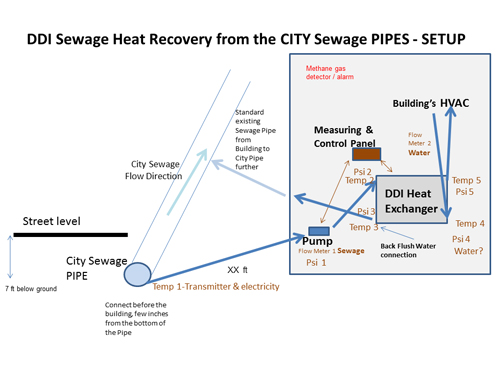

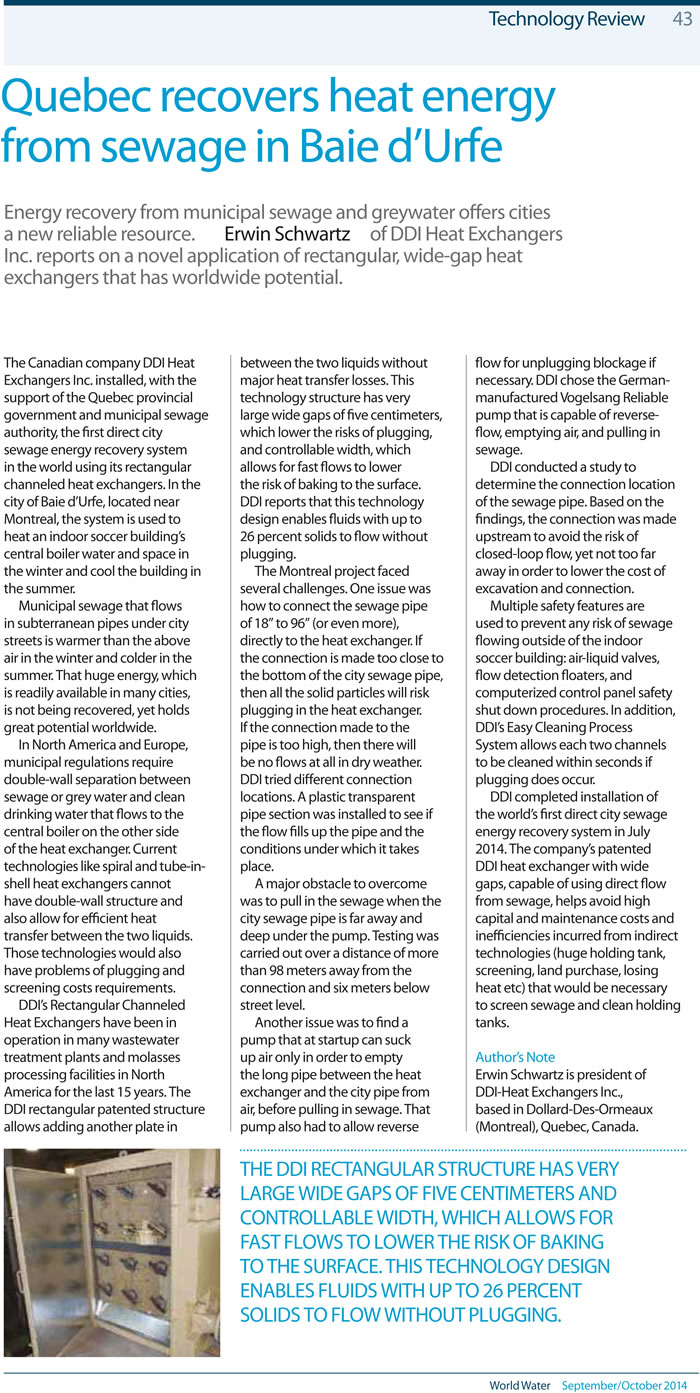
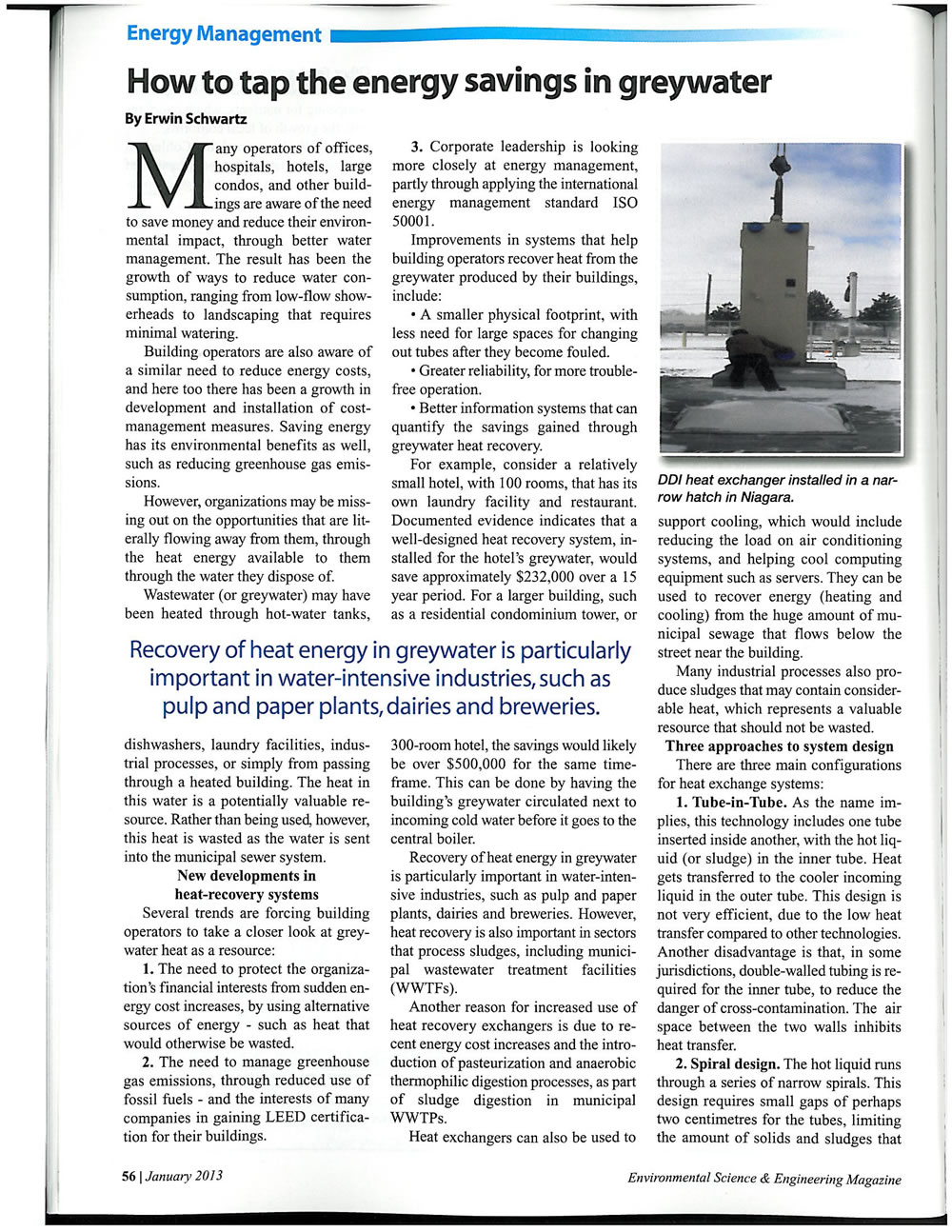
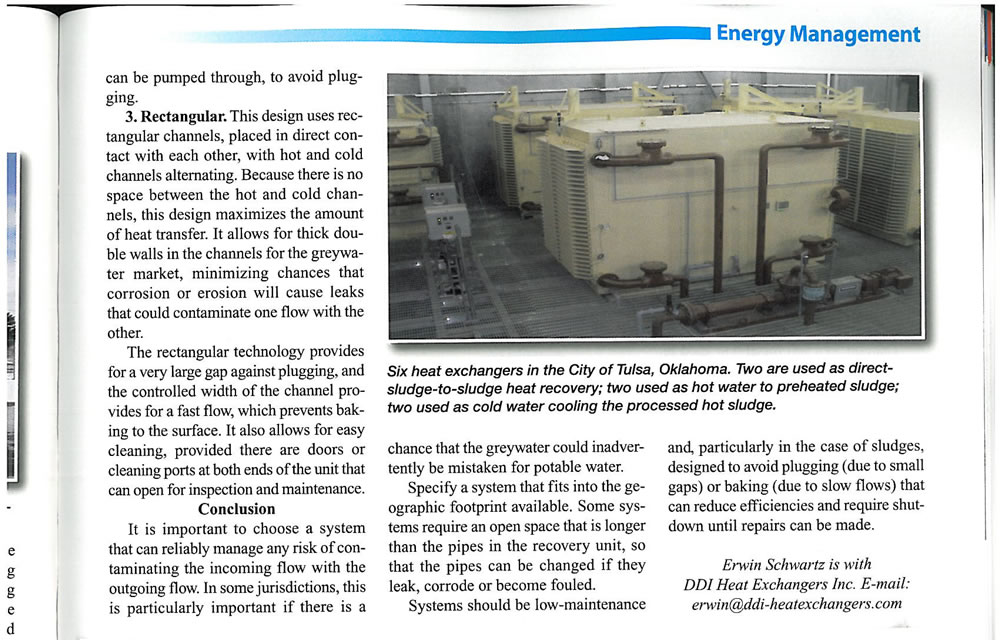

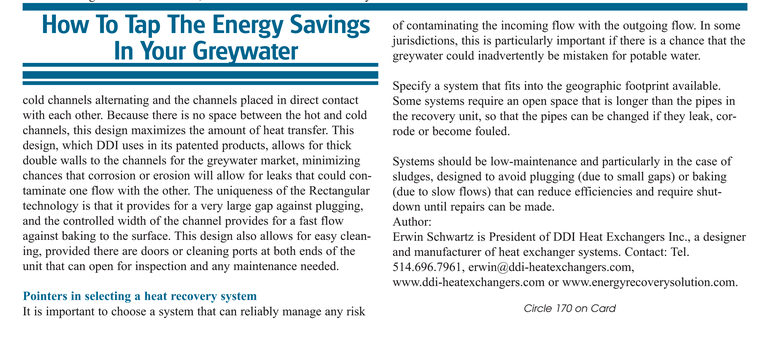
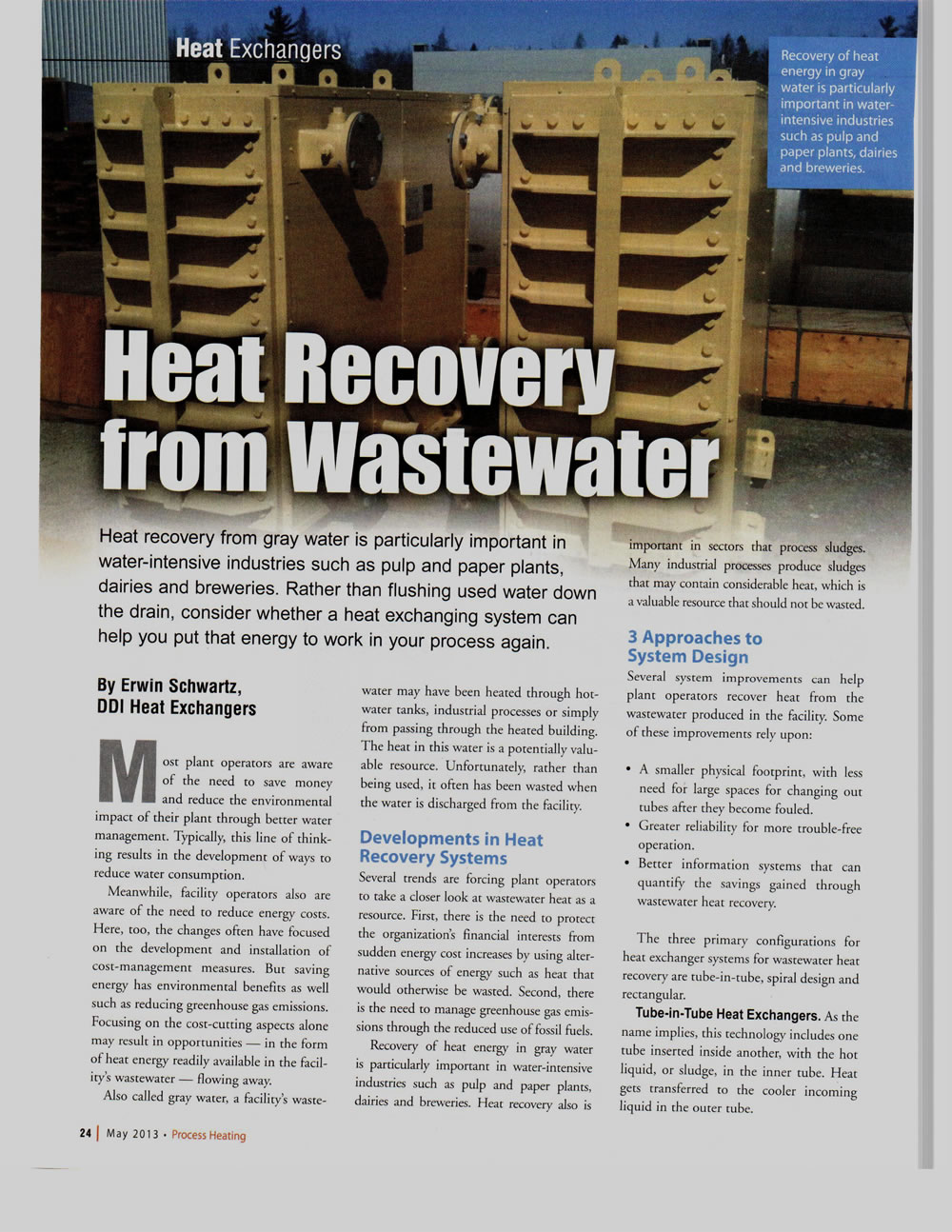
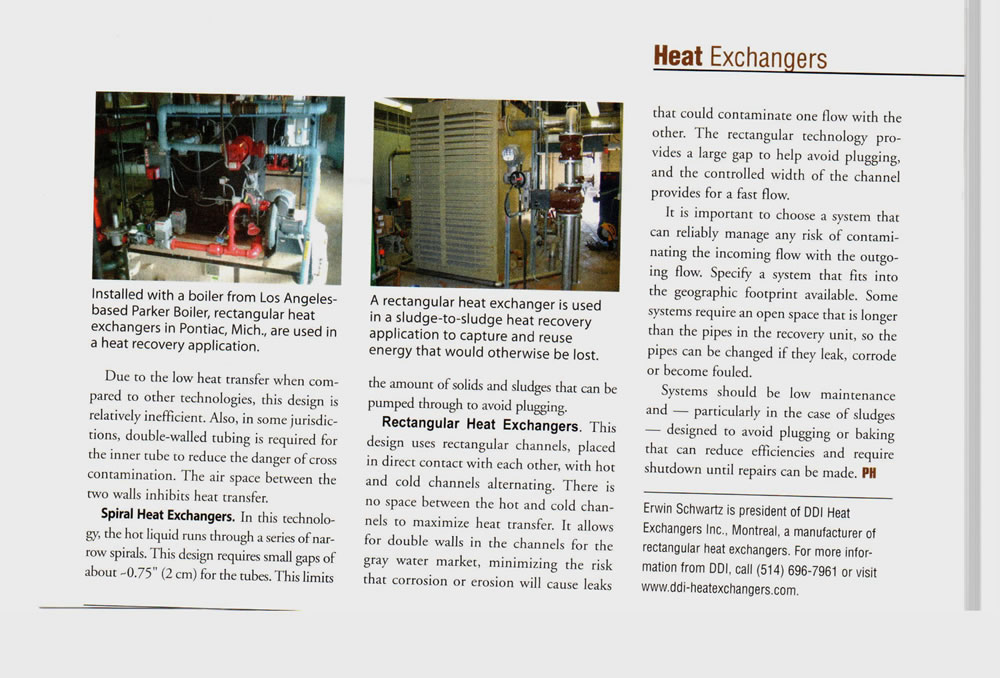





 Views Today : 160
Views Today : 160 Total views : 350379
Total views : 350379